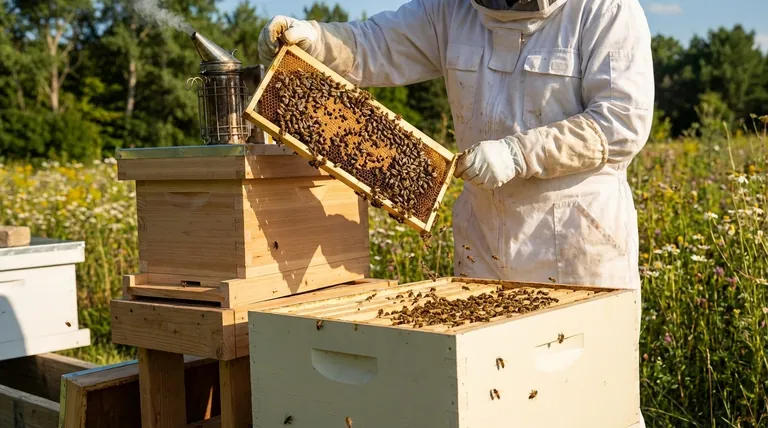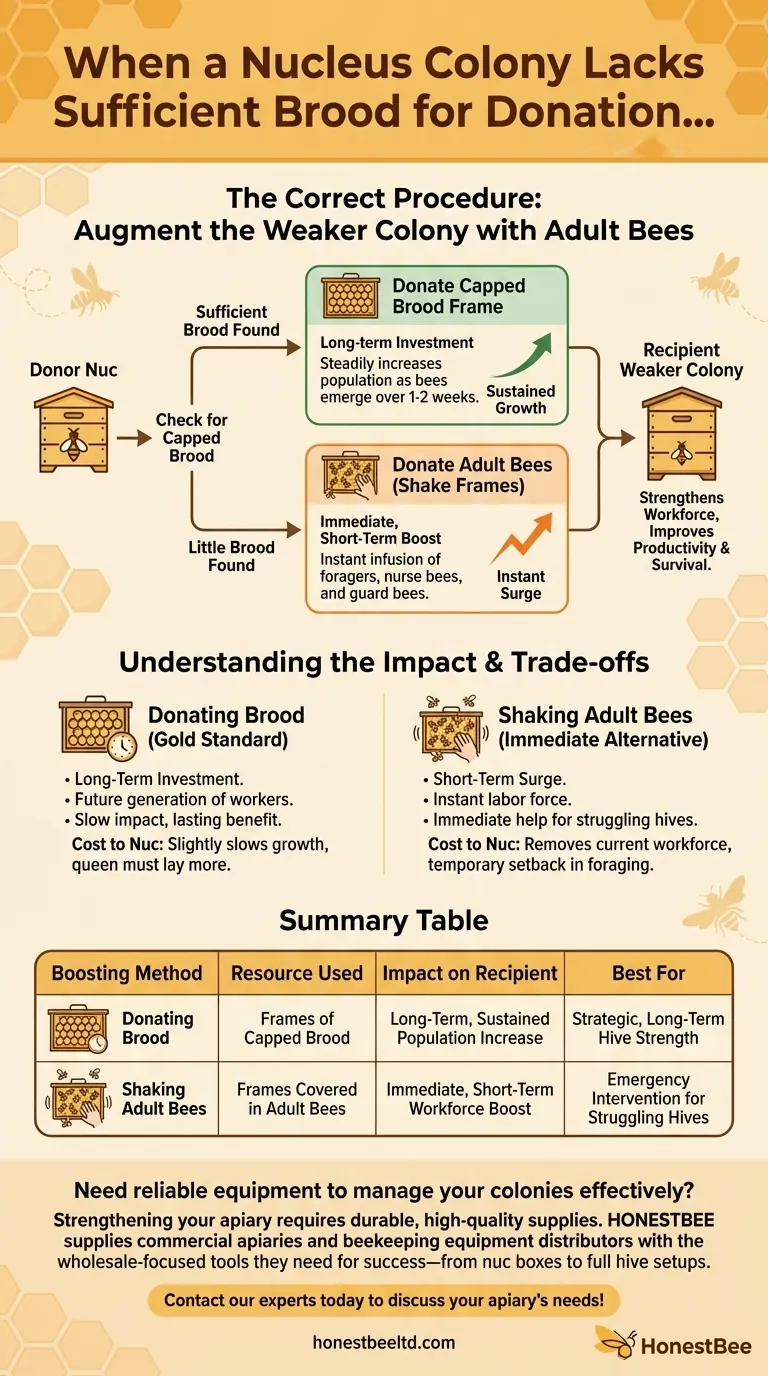When a nucleus colony lacks sufficient brood for donation, the correct procedure is to augment the weaker colony with adult bees instead. You can accomplish this by locating frames with a high density of bees in the nuc, carrying them to the target hive, and shaking the bees directly into the supers. This provides an immediate, though temporary, boost to the weaker colony's workforce.
Boosting a weak colony is about increasing its population to improve productivity and survival. While capped brood is the ideal resource for a sustained, long-term increase, donating adult bees is a highly effective short-term solution when brood is unavailable.

The Goal: Strengthening a Weaker Colony
The primary reason to transfer resources from a strong nucleus (nuc) to a weaker production colony is to increase its population. A larger population can forage more effectively, better defend the hive, and care for more brood, creating a positive growth cycle.
Why Capped Brood is the Gold Standard
The most effective way to strengthen a hive for the long term is by giving it frames of capped brood.
Capped brood represents the next generation of workers. As these young bees emerge over several days, they provide a steady, sustained increase in the colony's population. This is a strategic, long-term investment in the hive's future strength.
The Immediate Alternative: Donating Adult Bees
If you open a nuc and find it has very little capped brood to spare, the focus shifts to its adult bee population.
By shaking frames covered in bees into the recipient colony, you provide an instant infusion of labor. This adds foragers, nurse bees, and guard bees to the workforce immediately, helping the weaker hive perform essential tasks right away.
Placing these new bees into the supers (honey boxes), rather than the main brood chamber, helps reduce conflict and encourages smoother integration into the colony.
Understanding the Population Dynamics
The resource you choose to donate—brood or adult bees—has a different impact on the recipient colony's timeline and workforce composition.
The Impact of Donating Brood
A frame of capped brood is a future investment. The boost is not immediate, but it is powerful and lasting as thousands of new bees emerge over one to two weeks. These young bees will progress through their roles, first as nurse bees and then as foragers, contributing to the colony for their entire lifespan.
The Impact of Shaking Adult Bees
Shaking in adult bees provides an instant surge in the colony's workforce. These bees are a mix of ages but will quickly integrate and begin contributing to whatever tasks are most needed, from foraging for nectar to feeding the queen and existing larvae. This can be a critical intervention for a hive that is struggling to gather resources.
Understanding the Trade-offs
While both methods are effective, they come with different costs to the donor nuc and benefits to the recipient colony.
The Cost to the Donor Nuc
Donating a frame of brood slightly slows the nuc's growth potential. The queen will need to lay more eggs to replace the donated frame.
Donating adult bees, however, has a more immediate impact on the nuc. You are removing its current workforce, which can temporarily set back its own foraging and growth until its next generation of brood emerges to replace the donated population.
The Benefit to the Recipient Colony
Brood provides a long-term, foundational population boost. Adult bees provide a short-term, emergency labor force. This immediate help can be exactly what a struggling colony needs to overcome a difficult period and resume its own growth.
A Critical Note on Health
Never transfer bees or brood from a hive that shows any signs of disease or significant pest infestation, such as Varroa mites. Doing so is the fastest way to spread problems throughout your entire apiary. Only use strong, healthy nucs as donors.
How to Choose Your Boosting Strategy
Your decision should be based on what you find in the donor nuc and the specific needs of the weak colony.
- If your primary focus is a long-term, sustainable population boom: Prioritize finding and donating frames of capped brood.
- If the donor nuc has no brood to spare: Shake frames of adult bees into the weak hive for an immediate, short-term workforce increase.
- If your goal is an emergency intervention for a struggling hive: Shaking in adult bees provides the instant labor needed to help the colony stabilize and recover.
Understanding when to use each method empowers you to make the best tactical decision for the overall health of your apiary.
Summary Table:
| Boosting Method | Resource Used | Impact on Recipient | Best For |
|---|---|---|---|
| Donating Brood | Frames of capped brood | Long-term, sustained population increase | Strategic, long-term hive strength |
| Shaking Adult Bees | Frames covered in adult bees | Immediate, short-term workforce boost | Emergency intervention for struggling hives |
Need reliable equipment to manage your colonies effectively? Strengthening your apiary requires durable, high-quality supplies. HONESTBEE supplies commercial apiaries and beekeeping equipment distributors with the wholesale-focused tools they need for success—from nuc boxes to full hive setups. Contact our experts today to discuss your apiary's needs and discover how our products support healthy, productive colonies.
Visual Guide

Related Products
- 5 Frame Wooden Nuc Box for Beekeeping
- Twin Queen Styrofoam Honey Bee Nucs Mating and Breeding Box
- Automatic Heat Preservation 6 Frame Pro Nuc Box for Honey Bee Queen Mating
- Styrofoam Mini Mating Nuc Box with Frames Feeder Styrofoam Bee Hives 3 Frame Nuc Box
- Plastic Transporting Bee Packages and Nuc Boxes for Beekeeping
People Also Ask
- How should the nuc be installed in the apiary? Ensure Colony Success from Day One
- What are the benefits of using nucs for beginning beekeepers? Ensure a Successful First Hive with a Head Start
- What are the benefits of moving nuclei around the apiary? Master Strategic Hive Management
- What is the advantage of overwintering a nucleus? A Strategic Asset for Beekeeping Success
- What frames should be moved into the queenless hive when requeening with a nuc? Ensure a Successful Queen Introduction



















